Related Research Articles
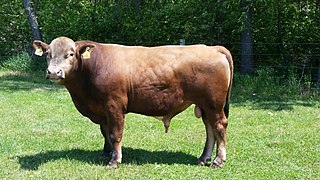
Beefalo constitute a hybrid offspring of domestic cattle, usually a male in managed breeding programs, and the American bison, usually a female in managed breeding programs. The breed was created to combine the characteristics of both animals for beef production.

The water buffalo, also called the domestic water buffalo or Asian water buffalo, is a large bovid originating in the Indian subcontinent and Southeast Asia. Today, it is also found in Italy, the Balkans, Australia, North America, South America and some African countries. Two extant types of water buffalo are recognized, based on morphological and behavioural criteria: the river buffalo of the Indian subcontinent and further west to the Balkans, Egypt and Italy and the swamp buffalo, found from Assam in the west through Southeast Asia to the Yangtze valley of China in the east.

Carabaos are a genetically distinct population of swamp-type water buffaloes from the Philippines. They descended from domesticated swamp buffalo populations from Taiwan that were introduced to the Philippines in the Neolithic via the Austronesian expansion. They were also further introduced to Sulawesi and Borneo of eastern Indonesia and Malaysia.

The South Devon is a British breed of large beef cattle. It originated in the counties of Devon and Cornwall in south-west England, and is mentioned from the eighteenth century. It was a dual-purpose breed, kept both for its milk and for beef. Since 1972 selection has been for beef only.

A bovid hybrid is the hybrid offspring of members of two different species of the bovid family. There are 143 extant species of bovid, and the widespread domestication of several species has led to an interest in hybridisation for the purpose of encouraging traits useful to humans, and to preserve declining populations. Bovid hybrids may occur naturally through undirected interbreeding, traditional pastoral practices, or may be the result of modern interventions, sometimes bringing together species from different parts of the world.

The Romanian buffalo, Romanian: "Bivol românesc", is a water buffalo breed from Romania.

The Anglo-Nubian is a British breed of domestic goat. It originated in the nineteenth century from cross-breeding between native British goats and a mixed population of large lop-eared goats imported from India, the Middle East and North Africa. It is characterised by large, pendulous ears and a convex profile. It has been exported to many parts of the world, and is found in more than sixty countries. In many of them it is known simply as the Nubian.
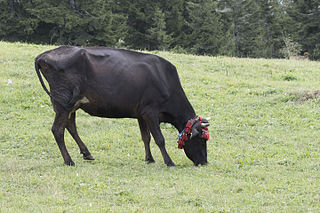
The Anatolian Black, also known as Native Black Cattle, is a breed of cattle that originated in Anatolia, in what is now Turkey. They are used in dairy production, meat production, and as draught animals on small farms. They are primarily raised in central Turkey.

The Armoricaine or Armorican is an endangered French breed of domestic cattle. It originated in Brittany in the nineteenth century. It has a red coat with white markings, and has short horns.

The goat or domestic goat is a domesticated species of goat-antelope typically kept as livestock. It was domesticated from the wild goat of Southwest Asia and Eastern Europe. The goat is a member of the animal family Bovidae and the tribe Caprini, meaning it is closely related to the sheep. There are over 300 distinct breeds of goat. It is one of the oldest domesticated species of animal, according to archaeological evidence that its earliest domestication occurred in Iran at 10,000 calibrated calendar years ago.
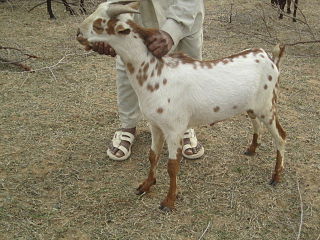
The Barbari or Bari is a breed of small domestic goat found in a wide area in India and Pakistan. It is distributed in the states of Haryana, Punjab and Uttar Pradesh in India, and in Punjab and Sindh provinces of Pakistan.

Bhadwari is an improved water buffalo breed from Uttar Pradesh, India, that is kept for milk production mainly in the Agra and Etawah districts, and in the Bhind and Morena districts of Madhya Pradesh. Cows usually lactate during 272 days with an average milk yield of 752–810 kg (1,658–1,786 lb) in this period.

Nili-Ravi is a breed of domestic water buffalo of Punjab. It is distributed principally in Pakistan and India, concentrated in the Punjab region. It is similar to the Murrah breed of buffalo, and is reared mainly for dairy use. The average milk yield is approximately 2000 kg per year; the record yield is 6535 kg in a lactation of 378 days.
The Surti is a breed of water buffalo found in the Kaira and Vadodara districts of Gujarat between the Mahi and Sabarmati rivers. Its average milk yield is 1,600–1,800 litres. The fat content of the milk is about 8–10 per cent. The best animals of this breed are found in Anand, Kaira and Baroda districts of Gujarat.
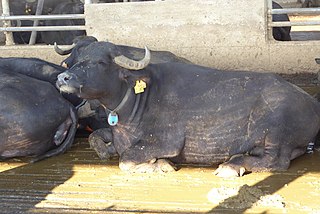
The Italian Mediterranean buffalo or bufala mediterranea italiana is an Italian breed of water buffalo. It is of the River sub-type of water buffalo and is similar to the buffalo breeds of Hungary, Romania and the Balkan countries. It is the only indigenous water buffalo breed in Italy. A herd-book was opened in 1980, and the breed was officially recognised in 2000.
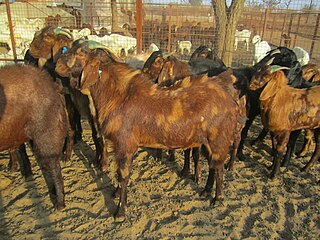
The Sirohi is an Indian breed of domestic goat. It is named for its area of origin, the Sirohi District of Rajasthan, in north-western India. It may be described as a dual-purpose breed, reared for both meat and milk production, or as meat breed. It is well adapted to the dry tropical climate of Rajasthan.
The Aspromonte or Capra dell'Aspromonte is an indigenous breed of domestic goat from the mountain massif of the Aspromonte, in the province of Reggio Calabria in Calabria in southern Italy, for which it is named. It is raised only in the province of Reggio Calabria, mainly in the Aspromonte, in the Altipiano dello Zomaro to the north-east, and in the Ionian coastal areas of the province, and particularly in areas of Grecanic culture. While the breed is thought to originate on the Aspromonte, it may have been influenced by the various other goat breeds, including the Abyssinian goat, the Maltese, and a type known as "Tibetan" with long silky hair, whose importation to Calabria in the early twentieth century is well documented.
Central Institute for Research on Buffaloes, Hisar, a publicly funded, institute for water buffalo research. It is located 170 kilometres (110 mi) from Delhi, at Hisar in the north Indian state of Haryana. It has a sub-campus, Bir Dosanjh, at Nabha. CIRB operates a nationwide network of 10 research centres working on breed improvement of the 7 main native breeds. CIRB, with over 20 laboratories for buffalo research, is the world's largest buffalo research institute with the widest range of breeds under study. With the aim of improving breeds and dissemination of information, CIRB has sold over 1,000 bulls, conducted ~200,000 artificial insemination in the field for the farmers' buffaloes with a 41% conception rate, distributed ~520,000 progeny tested frozen semen kits to 45,000 farmers and over 250 institutes, imparted training to several thousand farmers on advanced buffalo husbandry, and created the world's first online Buffalopedia in several languages. It has a large research partner network across India and the globe. It is the second institute to successfully clone a buffalo in 2016, after the first successful cloning was achieved by the National Dairy Research Institute, Karnal in 2010. In July 2017, the Indian Council of Agricultural Research ranked CIRB Hisar as India's number one Buffalo research institute for the year 2016–17.
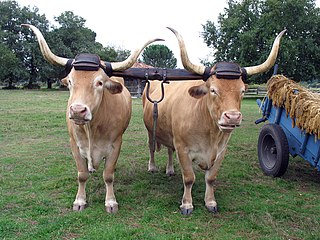
The Béarnaise is a French breed of domestic beef cattle. It originates in the area of the traditional province of Béarn, in the east of the département of Pyrénées-Atlantiques, in the northern Pyrénées in south-west France. It was merged with other breeds in 1920 to form the Blonde des Pyrénées, which in turn was fused with the Blonde de Quercy and Garonnaise breeds to create the Blonde d'Aquitaine in 1962.
Banni buffalo, which are also known as "Kutchi" or "Kundi", is a breed of buffalo found primarily in the Kutch district of Gujarat, India. The word 'Banni' is specific to not only the buffaloes but as well as the pasture grass species which are native to this region. This breed of buffaloes is usually bred and preserved by a local community found in Kutch, called the 'Maldharis'. An average Banni buffalo yields around 12 to 18 litres of milk each day.
References
- ↑ Breed data sheet: Pandharpuri. Domestic Animal Diversity Information System of the Food and Agriculture Organization of the United Nations. Accessed September 2013.
- ↑ Pandharpuri. Central Institute for Research on Buffaloes. Archived 3 February 2010.